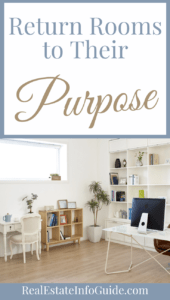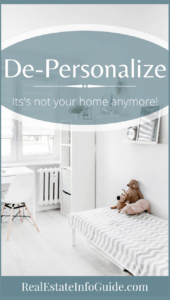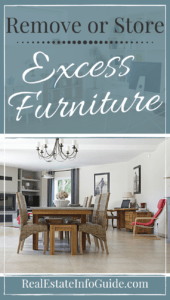 Staging a home is part art and part science, but you do not have to be an expert to stage your home to sell. There are plenty of ways you can make your home more appealing to the widest pool of potential buyers, many of which cost nothing more than tie and effort.
Staging a home is part art and part science, but you do not have to be an expert to stage your home to sell. There are plenty of ways you can make your home more appealing to the widest pool of potential buyers, many of which cost nothing more than tie and effort.
So, here are my top 20 ways to stage your home to sell. Use one, use some, use all. Use what works best for you and your home and good luck on your home selling journey.
Change Your Mind
The first thing to do when you stage your home to sell? Change how you think of your home. As soon as the decision is made to put the home on the market, begin to distance yourself emotionally.
Buyers do not want to view your home, they want to see a property they can see themselves living in. To make this easy, you need to strip as much of your unique personality as possible out of the building and make it somewhere anyone could call home.
Deep, Deep Clean
Now is the time to roll up your sleeves and clean like you ave never cleaned before. Go room by room and start by clearing everything you can out of the space. Wash the ceiling, work your way down the walls and then clean the windows. Give doors, window and door frames and any other moldings a thorough scrub and finish up with the floor. Steam clean any carpets that are staying in place and clean each item of furniture before you return it to the room.
Don’t forget to wash any window coverings, blinds, and soft furnishings.
Include any items you intend to pack or put into storage. That way you will be moving clean items into your new home.
Perfect Your Paint
While you love that lime green in the dining room doesn’t mean all potential buyers will. No matter how well it is done. Some might, but not all.
To appeal to as many buyers as possible, go neutral, but be careful, don’t go boring. Neutral doesn’t mean painting the property from top to bottom in white or a drab off-white/beige. That can work for some properties, but not all.
Instead, look for pale blues and greens to make rooms feel sunnier and lighter, choosing colors that coordinate with the existing flooring and any furniture and soft furnishings you will be putting back into the room.
If you cannot afford to redecorate your home, don’t worry. Try to invest enough to tone down any vibrant colors and ensure your existing paint is clean.
Fix It
While you are cleaning as you have never cleaned before, make a note of any repairs that need seeing to. I’m not talking about the big in-your-face things like a hole in the drywall made by the kids playing football indoors. No. I mean the things such as a cracked tile in the kitchen, flaking or dirty grout, or a missing shade on the light fixture in the washroom, things like that.
Many people make the mistake of thinking these items are so small that buyers won’t be bothered by them, but the opposite is true. Lots of tiny fixes not only give the impression that the home is uncared for – and in that case what other issues are hiding? – but they give buyers a to-do list, which is a huge turnoff for many.
Prioritize
Not every space in a home is created equal. According to a National Association Off Realtors survey about staging as far as buyers are concerned, the most important rooms to stage are, in order of importance:
- Living room
- Master bedroom
- Kitchen
- The yard or other outside space.
- Dining room
- Bathroom
- Children’s room
- Other rooms
Therefore, if you have a limited amount of time or money start at the top of this list and work your way down, staging as you go.
However.
That’s not to say you shouldn’t deep clean, declutter and carry out all the other no cost staging actions in every room. You should. Nor should you pour your entire budget into the living room and create discord between it and the rest of the house.
Instead, “Free-Stage” every room and then split your budget in a way that makes sense within the context of the survey results.
Low-Cost Upgrades
Some sellers make the mistake of believing if they can’t install new kitchens and bathrooms there’s no point in doing anything to these rooms.
Nothing could be further from the truth. In fact, it can be difficult to recoup the cost of a new kitchen and, unless these rooms are very rough, you will get more bang for your buck by making a few low-cost high-impact upgrades such as one or more of the following:
- Replace cabinet doors, handles, and/or drawer fronts. Alternatively, if the doors and drawer fronts are in good condition, paint them.
- Install a pedestal sink – this makes the area around the sink look bigger and brighter.
- Swap out faucets for new, slightly higher-end models.
- Install better quality, matching towel rails and other bathroom fixtures.
- Replace the caulking around sinks, baths, and showers.
- Install a new back-splash – there are many high-quality stick-on options available these days.
 Return Rooms To Their Purpose
Return Rooms To Their Purpose
Unless you have a huge, sprawling home with plenty of “spare” rooms every room in your home should be staged according to the layout of the home and the rooms expected purpose.
So if you have turned your dining room into an artist’s studio, turn it back into a dining room. People want dining rooms more than they want artists’ studios. If you have a three-bedroom house in a family neighborhood and you use one room as an office, think about this.
The majority of buyers will be looking at your house as a three-bedroom home and will be coming to view it with that in mind. If those buyers turn up and see your bedroom, a guest room, and an office then sub-consciously they will think of your home as a two-bedroom house with an office and are more likely to knock your abode off their list.
Yes, an office is useful, but if a buyer wants one, let them convert a bedroom, don’t do it for them.
And finally, think about the layout. Turning an upstairs bedroom into a living space and a downstairs living space into a bedroom may maintain the “correct” number of bedrooms, but potential buyers will find this layout odd and find it difficult to imagine how they will live in the home.
Give Spaces A Reason For Being
Now, just to be difficult I’m going to give you what seems like, at first, some advice that directly conflicts with what I said in the last point. But it doesn’t. Not quite.
If you have odd spaces, such as an empty spot under the stairs where you accumulate items or a room with an irregular alcove that sits empty, give it a purpose. As long, of course, that it is in keeping with the surrounding areas of the home.
So, that spot under the stairs? Place a small, light-colored desk and chair in there, with a few, small accent pieces and you have a useful homework or home office space. The irregular alcove? Place a small, comfy chair or some floor pillows and a side table and low and behold you have a reading nook.
Another Contradictory Way To Stage
Again, having said you should ensure that rooms are staged according to their expected purpose, there is an exception. The basement.
If you have an unfinished basement that is big enough to be converted into a useful room, make sure your potential buyers see the potential. Ensure the basement is as clean and empty as possible. Then lay a rug or some rubber matting and set up a “room” such as a mini yoga studio, a playroom or other bonus room.
Let Buyers See The Bones
A popular and well-documented way to stage your home to sell is to declutter, but not everyone really understands the correct definition of decluttering. It isn’t a case of getting rid of absolutely everything from every surface. Nor is it throwing precious and much-loved items away.
Instead, decluttering is about striking a balance between having so many things about that it prevents a buyer from seeing the bones of the home, and stripping a home bare so that it feels like a stark, unwelcoming prison.
So, you want to remove everything from every surface and then replace enough items to make it feel like a home. This is especially true in the kitchen and bathroom where surface space can be at a premium and you want to make the most of every square inch.
Even without the benefit of making your home more attractive to buyers, decluttering is an excellent course of action to take before you move home. By repurposing, recycling, donating or otherwise getting rid of anything you no longer want or need, you will have less packing and unpacking at either end of your move. You may also save money on moving costs so it’s an all-round winning way to stage your home to sell.
 De-Personalize – It’s Not Your Home Anymore
De-Personalize – It’s Not Your Home Anymore
Remember way back a the beginning of this article when I said to adopt a mindset where you are no longer the homeowner? This way to stage is strongly related to that.
Remove as many personal items as possible from your property. Take the family photographs and the framed kid’s artwork you love and pack it all away. Think of it as getting a jump start on your packing to move to your new home.
The same goes for any personal items linked to family history, your professional life, travel, etc. There is nothing wrong with being proud of who you are and where you come from. It’s just that when you are trying to sell your home, it is best to be as neutral and unassuming as possible.
Optimize Your Storage
There may have been a time when potential buyers would walk politely around a property and never dream of opening a cupboard or drawer. Thankfully, it is no longer considered rude to get a good look at every element of a home you might be about to sink a considerable amount of money into so buyers can, and will, have a good poke about in cupboards, closets and any storage area, nook, or cranny there may be in your abode.
As a result, you need to stage your storage to sell your home. Taking a page out of the decluttering handbook, go through every closet and aim to have each one of them half-full at the very most, less if you can manage.
Vacuum bags are fabulous for shrinking the amount of space needed for clothes, storage boxes look better on shelves than untidy bundles of bags, belts, etc, and footwear should be stored tidily.
The same goes for all other storage in the home.
 Remove, Or Store, Excess Furniture
Remove, Or Store, Excess Furniture
The longer you live in a house the more likely you are to have acquired a fairly large collection of furniture, big and small. There might be that side-table that was part of a set, the rest of which are long gone or those chests of drawers you have filled a room with so you can house your extensive tee-shirt collection.
The more furniture you have in a home, the smaller and more crowded it will look, it can even make it difficult to move around rooms making it feel claustrophobic for potential buyers. So, stage your home to sell by thinning out the amount of furniture you have in your home.
Choose the nicest, most coordinated, or contrasting items you have and put everything else into storage. Then you can arrange what’s left to put the best possible face on your home.
Arrange Your Furniture
It’s not all about how much you have, it’s what you do with it that counts. So be sure to arrange your furniture in such a way that you make your property appealing to buyers.
How do you do this?
- Don’t push all of your furniture against the wall. Instead, although it is counter-intuitive, float your furniture away from the walls, leaving space around them. This works especially well if you can arrange items around a piece of accent flooring.
- Place accent tables, chairs, or other pieces of smaller furniture in pairs if possible. Items of furniture placed in this way look more appealing.
- Give each piece of furniture a reason to be there. Don’t stick a random chair in a corner and expect it to look good. It won’t, it will just look odd.
Rent Some Furniture
If you are trying to sell an empty home, or if you find yourself with a stark looking property which you need to make more homely, consider renting some furniture.
This is also an excellent option if you want to create a more cohesive look to your home as you can rent complete rooms in which all the elements are already coordinated, right down to knick-knacks and artwork.
Stage The First Impression
One way to stage your home to sell is to ensure the entrance to your home is clean, appealing and inviting. First of all, wash down your doors and the surrounding area. Then, if necessary, give it a fresh coat of paint. New door furniture is a good bet and so is a mailbox, some planters or other accent pieces that are in keeping with the style of your home.
Small Touches
Stage your home by taking care of the little details. This can either create the impression the buyers are expecting, or create an exciting uninspected impression – which can be a good thing, or bad, depending on how far you go down that path.
So try things such as
- Hanging window treatments that are the same color as the wall. Or painting the wall the same color as your window treatments! This creates an unbroken run of color which can make your home look bigger.
- Stagger your artworks. Instead of hanging a row of paintings in a straight line in the same way as everyone else, consider staggering them to draw the viewer’s eyes in that direction. This encourages people to pause longer in a room and to really look around instead of having their eyes quickly skim past everything.
- Use bedding and cushions to give a luxurious feel to a bedroom without breaking the bank. Fresh linen, accent pillows, plain colors with a throw adding a splash of pattern, these all contribute to a higher-end feel and there’s the bonus that you can take it all with you when you move.
- Break up large empty surfaces, such as a dining room table with something interesting but not over-powering. So, a plate with some ornamental items arranged on it would work as long as it was in proportion to the table and the room. A giant figurine of a ginger cat that is “crouching” to cover the entire table, not so much.
- When using ornaments, figurines, sculptures, and other decorative items, arrange them in odd numbers, preferably in three’s. It is also more appealing if they are of different heights.
Stage For The Nose
Yes, we have all heard, for years, that you should brew some coffee and bake some cookies or bread before a potential buyer comes to view your home. The trouble with this is that every buyer on earth also knows this and the smell of coffee and cookies has swung the other way.
Instead of making the buyer feel comfortable, relaxed, and at home, buyers are reporting that it makes them feel that the seller is trying to manipulate them or that the seller is trying to cover something up.
So.
Skip the cliches and stick to the basics:
- Foster out your beloved pets, along with their food, bowls, bedding, beds, and extensive collection of chewy toys. Yes, they are part of the family and you shouldn’t have to send them away but remember you don’t HAVE to. It is just the way the world works that some buyers will be turned off by a home that smells of pets so if you want to appeal to them, you’ll have to send your fur babies on a little holiday. This also goes for fishtanks, house rabbits, rodents large and small in cages or any other pet that has a distinctive aroma.
- Reduce your own use of strongly fragrance products. Smells have strong associations and you never know which aromas may have negative connotations, albeit subconsciously, for your potential buyers.
- Stick to “clean” smells. Cleaning products that are lightly fragranced with citrus or “fresh laundry” type smells have an association with general cleanliness which will appeal to a buyer.
Don’t Forget The Outside
Another way to stage your home to sell is to include the outside and I’m not talking about a quick tidy up and planting a few bright flowers.
Put away all tools, unused garden furniture, children’s toys, etc. Then arrange some seating to create an appealing social area where people can sit and talk. If appropriate you can use outdoor cushions, rugs, side tables and dishes to create a garden oasis that any buyer could imagine themselves relaxing in.
Pay Someone To Do It
Finally, if you have the money, you can always pay a professional stager to stage your home to sell. Many real estate agents have connections in the staging industry and may be able to get you a reduced rate or have the stager defer payment until after you have sold your home.
Final Thoughts
There are many ways to stage your home to sell, and in some ways, I have only scratched the surface here. But by doing everything you can to create an appealing home for your target buyer, you will maximize your chances of a timely sale at a price that works for you.
About The Author
 Geoff Southworth is the creator of RealEstateInfoGuide.com, the site that helps new homeowners, investors, and homeowners-to-be successfully navigate the complex world of property ownership. Geoff is a real estate investor of 8 years has had experience as a manager of a debt-free, private real estate equity fund, as well as a Registered Nurse in Emergency Trauma and Cardiac Cath Lab Care. As a result, he has developed a unique “people first, business second” approach to real estate.
Geoff Southworth is the creator of RealEstateInfoGuide.com, the site that helps new homeowners, investors, and homeowners-to-be successfully navigate the complex world of property ownership. Geoff is a real estate investor of 8 years has had experience as a manager of a debt-free, private real estate equity fund, as well as a Registered Nurse in Emergency Trauma and Cardiac Cath Lab Care. As a result, he has developed a unique “people first, business second” approach to real estate.
Check out the Full Author Biography here.
This article has been reviewed by our editorial board and has been approved for publication in accordance with our editorial policy.

